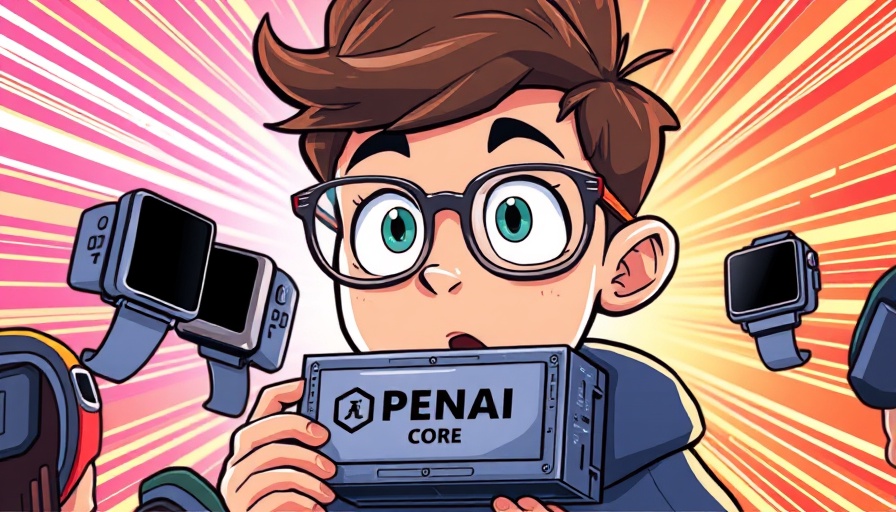
OpenAI's Bold Bet: A Revolutionary AI Companion Device
In a recent announcement from the tech forefront, OpenAI, under the visionary leadership of Sam Altman, is gearing up for a major leap into consumer hardware with an AI device designed to enhance everyday life. The news of famed Apple designer Jony Ive joining OpenAI has sparked significant excitement and speculation regarding this forthcoming product. However, clarity is emerging as discussions clarify its form and function, ultimately suggesting it won't be a wearable.
In the video titled 'OpenAI Hardware Device (Probably) Won't Be a Wearable,' discussions about this innovative AI device reveal key insights into its design and potential impact on everyday business practices.
Reimagining AI Integration Into Daily Life
Altman emphasized the device’s capability to fully engage with a user’s environment, hinting at an innovative approach to AI that respects the nuances of personal space and practicality. Unlike other AI ventures that aim for near-visibility, this device is envisioned to seamlessly fit into a user’s routine, resting unobtrusively on a desk or in a pocket. The challenge lies in creating a product that can penetrate the market while avoiding the stigma associated with wearable tech—a hurdle many are still grappling with.
Why This AI Device Matters for Business Owners
For business owners, the implications of OpenAI’s developments could be transformative. An AI device designed to assist in everyday tasks could enhance productivity, streamline operations, and elevate decision-making processes. After all, if Altman's vision realizes a tool that acts as a third core device alongside laptops and smartphones, it could signal a fundamental shift in workplace dynamics.
Anticipated Speed and Secrecy: The Competitive Edge
Altman’s assertion that OpenAI is on track to ship this AI companion faster than any company has managed before is bold, but it highlights the urgency in today’s tech race. With competitors already eyeing the horizon, the emphasis on secrecy surrounding the product adds layers of intrigue. How OpenAI navigates trust within its culture while racing against competitors will be essential for the company’s reputation and market viability.
Counterarguments on Device Wearability
While the device is not aimed to be wearable, it’s worth considering why this decision was made. Critics of wearable devices point to the societal resistance against adopting technology that blurs personal boundaries. Discussing this aspect provides insights into consumer behavior—many people resist products perceived as intrusive, especially when they enhance monitoring or surveillance capabilities. OpenAI’s strategic choice could reflect a deeper understanding of market psychology.
The Future of AI in Business Communication and Interaction
As AI technology evolves, so do its applications. Just recently, Zoom’s CEO used an AI avatar during earnings calls, a trend that some tech leaders are beginning to adopt. This trend towards virtual avatars demonstrates how companies can enhance communication while maintaining engagement with their audiences. As business owners, adopting such technologies does not just enhance outreach; it can change the fabric of internal and external communications.
Exploring Google’s Scrutiny: Factors Affecting the AI Landscape
The broader implications of emerging technologies include regulatory landscapes. Google faces scrutiny regarding its market strategies, which include the acquisition of AI start-ups like Character AI. As this investigation unfolds, it showcases the delicate balance that tech giants must maintain between innovation and compliance. The outcome could significantly reshape the competitive landscape of AI technology and acquisition strategies among companies.
The Potential Impact of OpenAI's Device Launch
The anticipation surrounding OpenAI's AI device is not just about technological advancement but about the doors it could open for business efficiencies and market operations. Should the device fulfill its promise, it could redefine the tools business owners have at their disposal, making it imperative for them to stay informed about AI developments.
As we witness these revolutionary changes shaping our society, the integration of whatever OpenAI unveils cannot be underestimated. For business leaders wanting to stay ahead, the time has come to explore how AI tools and strategies can be incorporated into their operations meaningfully.
START USING AI NOW to equip your business with cutting-edge technology and innovate your operational capabilities. Understanding the advancing landscape of AI is crucial for sustained success in today’s fast-paced environment. Don’t miss the opportunity to integrate AI tools that can propel your business forward.
 Add Row
Add Row  Add
Add 




Write A Comment